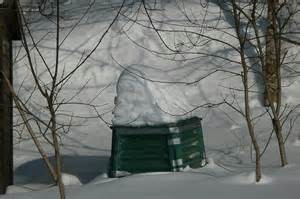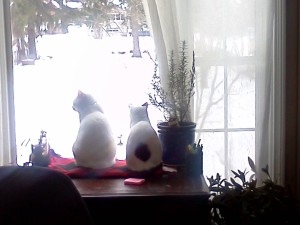Winter Composting: Jumpstart Your Spring Garden
Composting is not only a great way to improve the quality of your backyard soil, but is also a terrific way to reuse kitchen scraps and other household waste.
This indoor waste recycling can dramatically cut down on the amount of trash that you generate per week. We went from 4-5 bags per week to 1 bag per week. See our article on reducing your trash.
But people who regularly compost kitchen scraps during the spring and summer usually stop doing so during the colder months. There are two reasons for this.
The first reason is that it is too cold or snowy to walk out to the compost bin and the second is that compost does not “cook” during the winter.
Nevertheless, all of the compostable household waste generated during the winter can and should be saved because once the weather begins to warm again, these materials will provide a jumpstart to the garden.
Before we discuss how to do this, let’s take a look at all of the things from inside the home that are compostable. The list may be bigger than you might think.
Items from the home that are able to be composted
- vegetable scraps: Any fresh vegetable matter can be composted. You would not want to use cooked food that contains fats and oils, but all of the choppings from the cutting board are fair game like the tops, peels, husks, seeds, etc. You may be surprised at how much material this adds up to be in a month’s time.
- coffee filters: The used paper filters and the grounds are all fair game. Toss them in.
- paper towels: yes it is ok. Any paper is fine as long as there are no chemicals. You may want to rip up or shred thicker paper.
- cardboard: yes it can be composted but it will not break down very fast unless you chop it up into small pieces (or shred it with a good quality cardboard shredder).
Pro Tip: Cardboard plays another important role in organic gardening and permaculture style gardening. It can be used as the bottom lining for raised beds, acting as a weed barrier. It can also be used when laying out new garden beds in the yard, acting as the first layer of sheet mulching. Check around our site for articles on these topics and you may find that used cardboard is more valuable for these activities than it is for composting. One last thing with cardboard: Don’t use glossy or colored cardboard because of chemicals. Stick to the brown stuff only. Also, remove and discard any plastic tape that is usually present.
- egg shells: these are fine
- tea bags: yes
- sawdust: go for it, but make sure that it is only in realistic-sized amounts. You don’t want to throw off the mix by adding too much sawdust so if you generate a lot of sawdust in the home, save it in a separate container and add it in to the compost bin in small amounts over time. You can also directly sprinkle it on to the garden beds or lawn in small amounts over time.
- bread, crackers, etc: perfectly fine, of course, you can also feed the wildlife with it.
- nuts: shells and all, and yes even walnut. Walnut shells do have an agent that retards plant growth, but as long as you are not going crazy with the amounts this is no big deal. If you have a ton of walnut shells, we like to grind them in a spice grinder or coffee grinder and use the powder to make skin products.
- fresh or cooked pasta and grains: as long as they are not coated in too much fat or oil, this is fine. Old popcorn: yes!
- houseplants: trimmings or dead plants and leaves are great
- wood ash: wood ash is ok to compost in small doses over time. If you find that you generate a lot of wood ash, consider saving it separately because there are a lot of things that can be done with it such as soap making for example. Wood ash can also be spread out directly on the lawn and over the garden beds in thin layers. You can do this right on top of the snow if desired. You can also clean your glass fireplace or wood stove door with it.
The great thing about reusing all of these materials for the garden is the huge reduction you will see in the amount of garbage that would normally go out to the curb.
When in doubt about what to compost
When in doubt about whether something can be composted, it is better to be on the safe side and not put it in. If you think something has chemicals or fats and oils, leave it out. Think natural. Do you really want junk mail, cat litter, and vacuum cleaner dust going into your garden soil? No.
How to compost in the winter
As mentioned, the compost pile or bin outside will not be actively working or “cooking” during the cold months and that is OK. All of the materials mentioned above can still be tossed into the compost bin outside and will just sit dormant until the weather warms up.
If you do not have a compost bin set up outside see our guide on how to set up a compost bin.
We normally keep our compost bin towards the back of the property because we like to keep it out of sight and also, it gives us an excuse during the warm months to get out into the yard.
During the warm months, having to walk a little bit to dump the indoor compost materials is a good thing as it allows you to inspect the garden along the way. We also usually grab a few weeds or yard debris along the way for the compost bin.
One tip for winter composting is in the late fall when the season is about to wrap up, move the compost bin close to the house. That way it is not an issue to dash outside to dump the indoor materials during the winter.
If you do not want to move the compost bin cloder to the house, set up a temporary container to hold the winter scraps. A garbage can near the house works great for this. Empty it into the compost bin in the spring.
If you generate a lot of compostable materials during the winter, you may consider setting up two bins near the house, one for the “green” material such as food and plant material, and another for the “brown” stuff like paper, cardboard, and sawdust.
Saving materials indoors
If it is not convenient or desirable to dump the indoor compostable materials into outside bins every time you have something to add to the bin, consider setting up a small indoor container to hold the scraps and then dump them out once a week.
We use a ceramic kitchen compost container. They come with a filter to reduce smells although there shouldn’t really be much smell as long as you are not adding oils, fats, meat, etc.
Another option would be to put a bucket under the sink for this purpose.
A note on compost mix
The ideal mix for compost according to the Colorado State University Extension is to add 2 parts “green” materials to 1 part “brown.” So in the compost bin outside, ideally you would want to achieve this ratio.
For “green” think Nitrogen and for “brown” think Carbon. So green would be the plant matter, coffee, etc. and brown would be the paper and woody materials.
Getting the proper mix is what makes the compost pile “cook.”
If you set up a bin near the house for green and one for brown materials, then in the spring, you can add these to the compost bin according to the 2 parts green and 1 part brown ratio.
Alternately, if you just have one bin near the house and it mostly contains green materials, toss in leaves (brown) once you add it to the main compost bin in the spring. You get the idea.
The mix does not have to be perfect.
Give it a shot and let us know what you think!
Thanks for reading, and please share this article if you found it helpful.

